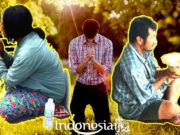Who doesn’t know one of the largest tribes in Indonesia? Yup, the answer is the Batak tribe, even though it is famous for its rough voice, even melodious. Did you know that the majority of the tribe living in Sumatra, which is full of highlands, is a cannibal? There’s even a Human Eating Ceremony?
“Cannibalism is a phenomenon in which a living being eats similar creatures. Suppose a dog that eats a dog or a human who eats a human. Sometimes this phenomenon is called the anthropophagus (Greek anthrôpos, “man” and phagein, “to eat”). Etymologically, the word “cannibal” is a word levy from Dutch which in turn derives from Spanish; “Canibal” which means people from the Caribbean. In this area by penj (el) ajah this phenomenon was found.
Ritual of cannibalism Apart from in the Caribbean, in America this was also the case in ancient times, for example among the Anasazi, Maya and Aztec peoples. Apart from that in Asia-Pacific, cannibalism has also been found. Among others, the Batak tribe in North Sumatra, the Dayak tribe in Kalimantan, the Asmat tribe in Papua, several other tribes in West and East Papua, Fiji and other Melanesian areas. In Papua New Guinea among the Fore tribe, cannibalism causes kuru disease.
If we hear the talk of people in the city of Medan and its surroundings who tell about the Batak ethnicity in ancient times, usually some of them will tell that in ancient times the Batak tribe were human flesh eaters, aka cannibals. For a moment we think “ah this is just a lie, or just scare”.
Is that true of the story? Let’s explore some of the testimonies of these past figures.
The ritual of cannibalism is well-documented among the Batak, whose aim is to strengthen the tondi (soul) of the human flesh-eating. In particular, blood, heart, palms and soles of the feet were considered to be rich in tondi.
In Marco Polo’s memoir, who had come on an expedition on the eastern coast of Sumatra from April to September 1292, he mentioned that he met people who told about the existence of inland people who were called “man-eaters”. From secondary sources, Marco Polo recorded stories about ritual cannibalism among the “Battas” people. Although Marco Polo only lived in the coastal area, and never went directly inland to verify the story, he was able to recount the ritual.
Niccolò Da Conti (1395-1469), a Venetian who spent most of 1421 in Sumatra, during his long voyages on trade missions in Southeast Asia (1414-1439), recorded people’s lives. He wrote a brief description of the Batak inhabitants: “In parts of the island, so-called Batech cannibals live in constant war with their neighbors”.
Thomas Stamford Raffles in 1820 studied the Batak and their rituals, as well as the laws regarding human flesh consumption, writing in detail about the justifiable offenses. Raffles stated that: “It is not uncommon for people to eat their parents when they are too old to work, and for certain crimes a criminal would be eaten alive, meat eaten raw or grilled, with lime, salt and a little rice”.
German doctor and geographer Franz Wilhelm Junghuhn, visited the Batak lands in 1840-1841. Junghuhn spoke of the ritual of cannibalism among the Batak people (whom he called “Battaer”). Junghuhn told how after a dangerous and hungry flight, he arrived at a village where the people are very friendly. The food offered by his host turned out to be the meat of two prisoners who had been slaughtered the day before.
Oscar von Kessel visited Silindung in the 1840s, and in 1844 was perhaps the first European to observe a Batak ritual of cannibalism in which an adulterer is punished and eaten alive. Interestingly, there is a parallel description from Marsden for several important points, von Kessel stated that cannibalism is considered by the Bataks as an act based on law and its application is limited to very narrow offenses namely theft, adultery, spying, or treason. Salt, red chilies and lemon should be given by the victim’s family as a sign that they accept society’s judgment and do not think about revenge.
Ida Pfeiffer visited the Batak in August 1852, and although he did not observe any cannibalism, he was told that: “Prisoners of war were tied to a tree and beheaded all at once, but blood was carefully preserved for drinking, and sometimes made into a kind of pudding. with rice. The body is then distributed; ears, nose and feet were the exclusive property of the king, apart from claims for some. The palms, soles of the feet, meat of the head, heart and liver are made into special dishes. Meat is generally grilled and eaten with salt. The women are not allowed to take part in large public dinners ”.
In 1890, the Dutch colonial government banned cannibalism in their area of control. Rumors of Batak cannibalism persisted into the early 20th century, and it seems likely that the custom had rarely been practiced since 1816.
Along with the entry of religions in the Land of Batak, such as Christianity and Islam, all traditions of cannibalism have become extinct, and all historical records of cannibalism in the Batak land have also been destroyed. Because it is contrary to the teachings of religion that developed in the Batak Land.
Currently the Batak tribe, after abandoning all forms of barbaric behavior and cannibalism, as an inland and isolated tribe, has developed into one of the most advanced tribes in Indonesia. “
So do you still judge that Indonesia consists of only Java and Bali?
source: wikipedia, kaskus forum






























